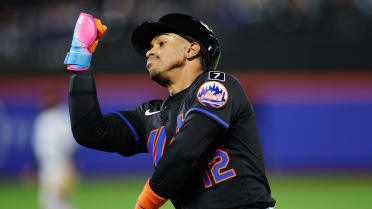A year ago, the Dodgers made a surprise trade to reacquire Matt Kemp, and the veteran outfielder enjoyed a rebound season by putting up his best offensive numbers since his first stint with Los Angeles, in 2014.
Now it's Russell Martin's turn to be back in Dodger blue -- and perhaps author a late-career resurgence.
Less than a month after sending Kemp on to Cincinnati, the club swung a trade with Toronto on Friday to land Martin, who referenced Kemp's 2018 All-Star season in his comments to reporters.
"There's something about putting on that Dodgers uniform that can bring out the magic in you," said Martin, who turns 36 next month and has one year remaining on his contract. "I hope to get some of that magic this year."
There is no "magic," of course. But there is reason to think that with some minor adjustments, Martin can achieve the rebound he seeks in his first season with the Dodgers since 2010.
In 2015 and '16 with the Blue Jays, Martin was basically a league-average hitter, posting identical weighted runs created-plus (wRC+) of 101. But that dropped to a 91 wRC+ last year, putting Martin about 10 percent below average while slashing .194/.338/.325. Given that MLB catchers as a group had an 84 wRC+, and that Martin is well respected for his work behind the plate, he certainly can contribute to the Dodgers without boosting his bat. But if he does, it would help the club make up for the departure of Yasmani Grandal.
"Last year was obviously a down year [offensively], but digging into it more, the quality of at-bat is elite and the batted ball profile is still strong," Dodgers president of baseball operations Andrew Friedman said of acquiring Martin, per MLB.com's Ken Gurnick.
The first point is certainly true. Of the more than 300 batters who saw 500 or more pitches out of the strike zone last season, Martin had the lowest chase rate (10.2 percent), beating out second-place Joey Votto. He also ranked among the MLB leaders in walk rate (15.9 percent), with a strikeout rate (23.3 percent) not far above the MLB average.
Friedman's second point, about Martin's batted ball profile, is also true -- in one sense. He still has plenty of thump in his bat:
Martin's 2018 MLB ranks, per Statcast™
Min. 200 batted balls (281 batters)
Average exit velocity: 90.6 mph (T-42nd)
(On line drives + fly balls): 95.4 mph (T-36th)
Hard-hit rate (95+ mph): 43.0% (T-52nd)
Martin actually hit the ball harder on average -- and hit it hard more often -- than in 2016 or '17. His average launch angle (10.1 degrees), while below the MLB rate (11.7), also was higher than before. Combine Martin's walk and strikeout rates with his hard-hit rate and average launch angle, and you get a profile strikingly similar to that of the Mets' Brandon Nimmo, who hit .263/.404/.483 (149 wRC+).
The thing about averages, though, is that they don't tell the full story.
Consider the following leaderboard, which FanGraphs' Jeff Sullivan previously pointed to:
Lowest rate of batted balls hit between 5-35 degrees, 2018
Min. 200 total batted balls (281 batters)
1. Russell Martin: 30.0 percent
2. Orlando Arcia: 31.2 percent
3. Eric Hosmer: 31.6 percent
4. Travis Jankowski: 32.2 percent
5-T. Avisail Garcia: 32.4 percent
5-T. Ian Desmond: 32.4 percent
MLB average: 40.9 percent
Hitting the ball at a launch angle below five degrees produces ground balls, resulting in a .242 MLB-wide slugging percentage last season. Hitting it above 35 degrees produces high fly balls and popups, resulting in an .058 batting average. That leaves a sweet spot in between that accounted for about 88 percent of all extra-base hits in 2018.
Focusing only on Martin's hard contact (exit velocity of 95-plus mph), fewer than half of his batted balls fell into that sweet spot, putting Martin in the bottom eight percent of MLB hitters. Simply put, even when Martin hit the ball hard, he produced too many easy outs.
Back in 2017, Martin made hard contact roughly the same number of times as in '18, but nearly 70 percent of those batted balls fell into the ideal launch angle range. That put him in the top eight percent of MLB hitters.
Perhaps Martin himself can make the adjustments necessary to move back in that direction. Perhaps the Dodgers, with their analytical approach and new hitting coach Robert Van Scoyoc in place, can aid that quest.
There's not a huge gap to overcome. The difference between Martin's 2017 and '18 seasons, over roughly 300 at-bats, was about eight hits and 18 total bases.
The odds are against any 36-year-old catcher, and Martin could continue to decline, losing playing time to Austin Barnes or another late addition. But with a tweak to Martin's launch angle, his return to L.A. could turn out to be a sweet one.
Andrew Simon is a research analyst for MLB.com. Follow him on Twitter @AndrewSimonMLB.



